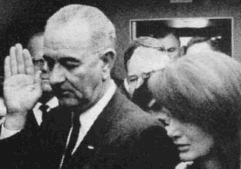 |
||
| In a television interview, A
Current Affair, the mistress of Lyndon Johnson,
Madeleine Brown, described the meeting of 21st November, 1963, when
she was at the home of
Clint Murchison. Others at the meeting included
Harold L. Hunt,
J. Edgar Hoover,
Clyde Tolson,
John J. McCloy and
Richard Nixon. At the end of the evening
Lyndon B. Johnson arrived... "Tension filled the room upon his arrival. The group immediately went behind closed doors. A short time later Lyndon, anxious and red-faced, reappeared... Squeezing my hand so hard, it felt crushed from the pressure, he spoke with a grating whisper, a quiet growl, into my ear, not a love message, but one I'll always remember: "After tomorrow those goddamn Kennedys will never embarrass me again - that's no threat - that's a promise.". It's important to note that John J. McCloy was a member of the now discredited Warren Commission which "investigated" the assassination, appointed by none other than Johnson. Nixon himself was in Dallas on the day of the assassination.
The lead prosecutor in this so called investigation is Sen Arlen Specter. Today, he is Chairman of the Senate Judiciary Committee, insuring that while he is alive, the miscarriage of justice perpetrated on an American president will never be addressed. |

| ||||||||||||||||||||||||||||||||||||||||
"I understood from the meeting that the president was his subordinate in Masonry...."
In 1957 Ray A. Neff of Gibbsboro, New Jersey, walked into Leary's bookshop in Philadelphia and purchased a faded, second-hand book for fifty cents. Unbeknownst to Neff, inside that dusty military journal was a profound and stunning confession from the grave of a Union General and traitor, Lafayette Baker. Booth was not alone, and according to Gen Baker, did indeed survive. And as late as 1977, the FBI, did in fact investigate the issue of JOHN WILKES BOOTH and his possible survival. (Recently the Bureau released 184 pages in PDF format: Part 1, Part 2, Part 3, Part 4.) According to the FBI, "These records contain correspondence dated 1922-23 of William J. Burns, former Director of the Bureau of Investigation, concerning a theory that Booth lived many years after the assassination of President Lincoln. Also included are the results of a 1948 examination by the FBI Laboratory of a boot said to be worn by Booth on the night of the assassination and a 1977 examination of a diary belonging to Booth." On January 23, 1923, William J. Burns, by then the acting director of the Department of Justice wrote "I have gone over with considerable interest the volume entitled "The Escape and Suicide of John Wilkes Booth" by Finis L. Bates of Memphis, Tennessee...The work contains very strong evidence in support of the old belief that Booth did escape and live many years after the assassination of President Lincoln..." (see page 12, booth1.pdf ) In fear for his life, Gen. Baker wrote the aforementioned confession before he was fatally poisoned with arsenic in 1868. If someone today could forge this confession, he would have to learn two different ciphers, and then invent a time machine, because he would have to perform the deed no later than October 1872. The book itself is referred to in a Philadelphia probate hearing held October 14 and 15, 1872; when William Carter testified that Lafayette Baker gave him an English military journal in the days before he died, which Carter tried to decipher but couldn't, even though he was familiar with codes from his days in the National Detective Police during the Civil War. Carter also testified that he saw Baker writing his coded memoirs in the margins of numerous books; the same which were the subject of the hearing, and that Baker tried to give him about a dozen boxes of books and papers. When John Wilkes Booth shot Lincoln, he was already famous for playing in Shakespeare's "Julius Caesar", and the allusion to Booth is obvious-- he's "one of the sons of Brutus". Johnson, who was in possession of a letter from Booth before the assassination, is also one of the the "sons". Judas was Edwin Stanton-- Lincoln's Secretary of War, whom at the moment Lincoln died, actually did say "Now the ages have him and the nation now have I." Both diaries, Bakers and Booth's, gave parallel accounts of the assassination. Both implicated, even boasted of a secret government council (the Scottish Rite) which in the interests of the British Crown has bound a nation, the United States of America, for over a century. (Gen. Baker's coded diaries, incidentally, were written in the margins of a British military journal; Colburn's United Service Magazine/Naval and Military Journal.) The coded book, its messages written in a sliding cipher, revealed that the true killers were led by Lincoln's most trusted military advisor in the Civil War: Edwin McMasters Stanton. About seven years later, the modus operandi described in that book was revisited in the Kennedy assassination. The infamous Lincoln and Kennedy parallels, for instance, are uncanny until you realize it was almost a copycat murder. The Lincoln and Kennedy murders were both bipartisan coups; and many of the masterminds in both assassinations belonged to the same Scottish Rite. This aforementioned international secret society, the largest, has its headquarters temple in Washington DC, and curiously, it presently houses the crypt of Confederate Gen. Albert Pike, a Tennessee Ku Klux Klan Chief Judicial Officer, Imperial Wizard and 33rd Degree Scottish Rite Sovereign Grand Commander. Much like we would see in 1963 in the Kennedy assassination; in 1865 at least two newspapers would publish highly detailed stories of the Lincoln assassination several hours before it ever took place. Moreover, in 1868 Lafayette Baker would confess in his coded diary that at least three newspaper publishers were involved, through blood money and disinformation, in the plot to kill Lincoln. Thus we move from the publishers' lucky premonition to outright foreknowledge and complicity. This, too, was a betrayal of the public's trust which the mass media repeated in 1963, but continues to maintain-- particularly through the New York Times (JFK) and the Los Angeles Times (RFK). As Anton Chaitkin wrote in the New Republic: "A striking instance of the Confederate 'Lost Cause,' persisting and haunting the present century, is to be seen in the attic of The New York Times. Iphigenie Ochs married Arthur Hays Sulzberger in 1917. He succeeded her father Adolphe Ochs as publisher of The Times, which Mr. Ochs had bought in the 1890s. Adolphe Ochs and his father founded the "Baroness Erlanger" Hospital in Chattanooga, Tennessee. The hospital was named forJohn Slidell's daughter who married the Confederacy’s chief financier Baron Emil Erlanger...Adolphe Ochs had married Iphigenie Wise, the daughter of B’nai B’rith’s Cincinnati leader Isaac Wise..." In Kennedy's case, intelligence agents in Russia read Soviet accounts of the Dallas ambush several hours before the hit took ever took place. By December, 1966, the KGB would finally determine Kennedy's true murderer, and they concluded it was Lyndon Johnson. When John Wilkes Booth shot Lincoln, he was already famous for playing in Shakespeare's "Julius Caesar", and the allusion to Booth is obvious-- he's "one of the sons of Brutus". Johnson, who was in possession of a letter from Booth before the assassination, is also one of the the "sons". Judas was Edwin Stanton-- Lincoln's Secretary of War, whom at the moment Lincoln died, actually did say "Now the ages have him and the nation now have I." Baker's decoded confession in Colburn's United Service Magazine, an English military journal, was dated February 5, 1868 and read as follows:
It was signed Lafayette C. Baker. And he wasn't as safe as he thought. Numerous attempts would be made on his life until he was finally poisoned with arsenic in 1868. His personal physician confirmed the poisoning by applying leeches behind his ears. Sure enough, as they became engorged, they dropped off dead. General Lafayette Baker, chief of the National Detective Police Force and fellow conspirator, wrote Stanton's plot was a vast, well financed gned Lafayette C. Baker. And he wasn't as safe as he thought. Numerous attempts would be made on his life until he was finally poisoned with arsenic in 1868. His personal physician confirmed the poisoning by applying leeches behind his ears. Sure enough, as they became engorged, they dropped off dead. General Lafayette Baker, chief of the National Detective Police Force and fellow conspirator, wrote Stanton's plot was a vast, well financed attempt to seize control of the federal government. According to witnesses who aided in John Wilkes Booth's escape, Booth told them this conspiracy involved fifty to one hundred; and thirty-five in Washington alone. | ||||||||||||||||||||||||||||||||||||||||
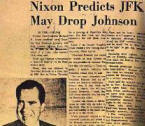
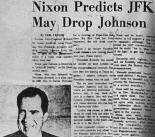 Hoover, Johnson and the '64 Election
Hoover, Johnson and the '64 Election

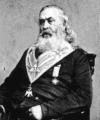






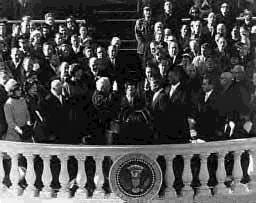 president. Another conspirator, Lewis Paine, is directly under the white lectern wearing a broad rimmed hat (smaller red circle). RIGHT: President Kennedy's inaugural oath was administered by Justice Earl Warren, a California freemason and former
president. Another conspirator, Lewis Paine, is directly under the white lectern wearing a broad rimmed hat (smaller red circle). RIGHT: President Kennedy's inaugural oath was administered by Justice Earl Warren, a California freemason and former 

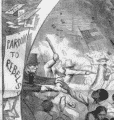



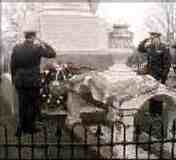 Clinton Lays on a Wreath on Andrew Johnson's Grave. Why?
Clinton Lays on a Wreath on Andrew Johnson's Grave. Why?